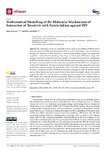2021-07-13Zeitschriftenartikel
Mathematical Modelling of the Molecular Mechanisms of Interaction of Tenofovir with Emtricitabine against HIV
Iannuzzi, Sara
von Kleist, Max
The combination of the two nucleoside reverse transcriptase inhibitors (NRTI) tenofovir disoproxil fumarate (TDF) and emtricitabine (FTC) is used in most highly active antiretroviral therapies for treatment of HIV-1 infection, as well as in pre-exposure prophylaxis against HIV acquisition. Administered as prodrugs, these drugs are taken up by HIV-infected target cells, undergo intracellular phosphorylation and compete with natural deoxynucleoside triphosphates (dNTP) for incorporation into nascent viral DNA during reverse transcription. Once incorporated, they halt reverse transcription. In vitro studies have proposed that TDF and FTC act synergistically within an HIV-infected cell. However, it is unclear whether, and which, direct drug–drug interactions mediate the apparent synergy. The goal of this work was to refine a mechanistic model for the molecular mechanism of action (MMOA) of nucleoside analogues in order to analyse whether putative direct interactions may account for the in vitro observed synergistic effects. Our analysis suggests that depletion of dNTP pools can explain apparent synergy between TDF and FTC in HIV-infected cells at clinically relevant concentrations. Dead-end complex (DEC) formation does not seem to significantly contribute to the synergistic effect. However, in the presence of non-nucleoside reverse transcriptase inhibitors (NNRTIs), its role might be more relevant, as previously reported in experimental in vitro studies.
Dateien zu dieser Publikation

